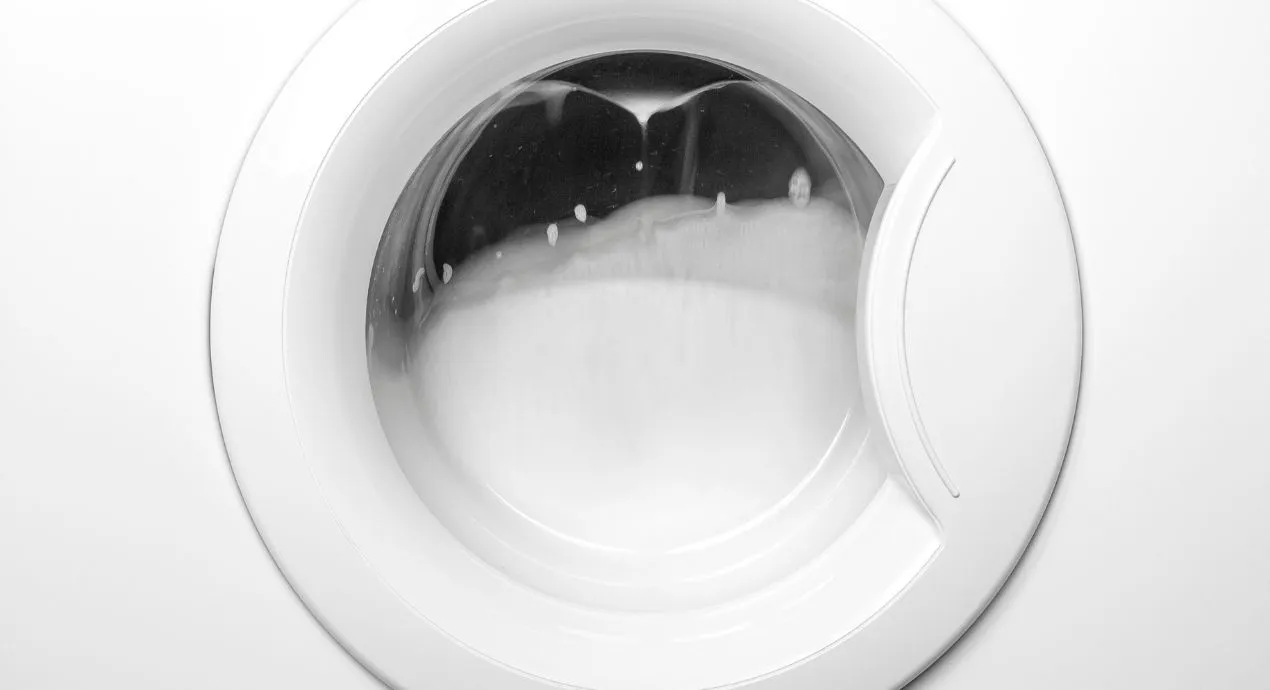
Contemplating coverage?
Subscribe to receive our emails & get
$200 off!
Have questions?
Call us: (833) 544-8273


Written By Ellie Brooks
Pooling water in your washing machine’s drum doesn’t necessarily mean that you’re about to be soaked by appliance repair costs. This problem can have more than one cause, but it’s often easy for the average homeowner to diagnose and fix.
In this article, we’ll run through a few washing machine troubleshooting tips to help you determine the reason for your washing machine’s drainage problem after a spin cycle. In the process, we’ll also review how to remove water from washing machine drum basins.
Slow drainage or standing water in washing machine drums can result from a simple clog or a malfunctioning mechanical component. But before we take a closer look at the most common causes, a word of caution: If your washing machine is still covered by the manufacturer’s warranty, you may want to avoid attempting to repair the machine yourself. Some warranties are voided when the user or an unauthorized technician disassembles the machine or attempts any kind of repair. If your washer malfunctions while still under warranty, it’s best to have the manufacturer resolve the problem.
Many washing machines—and especially older models—have drain filters to catch hair, lint, pieces of fabric, and other debris. Most manufacturers and home experts recommend cleaning these filters every three months or so. An excessively dirty filter can impair the washing machine’s efficiency and, yes, cause slow drainage.
The placement of the drain filter varies from model to model. Some washing machines have a filter behind a small hatch or access panel in the front of the unit. This panel may be secured with screws, or it may come off freely. Other models have the filter at the end of a drainage hose within or behind the unit. The filter could also be under the central agitator or uppermost rim of the drum in a top-loading washer.
When in doubt, consult your machine’s manual or contact the manufacturer to locate and assess the condition of the drain filter.
All washing machines have a drain hose to syphon away wastewater. This is usually made of rigid plastic that has been corrugated to allow for flexibility. Any kind of obstruction in the drain hose of course means that the washing machine’s wastewater has nowhere to go.
To check your machine’s drain hose, unplug the appliance and move it away from the wall. First, visually inspect the hose for tight bends or kinks. It’s possible that you inadvertently pinched or twisted the hose the last time you moved the machine.
If a twist or kink doesn’t appear to be the problem, there could be a clog. Set a large bucket beside the washer and remove the hose from the wall, keeping the free end elevated. Place the hose in the bucket to see if water drains from the machine. If not, run a plumber’s snake through the hose to check for a clog. Balls of lint, clumps of hair, and even small clothing items are all possible obstructions.
If your drain hose is clear and water drained freely when you disconnected the hose from the wall, then it’s possible that a faulty pump is responsible for your machine’s poor drainage. You may have noticed that your drain hose is elevated, connecting to the wall some distance above the washer itself. The pump works to expel water from the machine and force it up through the drain hose.
Drain pumps are susceptible to clogs, and they can malfunction just like any other mechanical appliance component. If you notice your washing machine leaking or making strange noises in addition to standing water in the drum, there’s likely an issue with your pump.
Check your drain pump by unplugging the machine and moving it away from the wall. You will likely need to remove a rear access panel. Remove the pump per the manufacturer’s specifications and inspect it for an obstruction. This could be hair, dust, lint, fabric, small clothing items, a coin, or some other item that you may have neglected to remove from your clothing’s pockets before starting a wash cycle.
If you don’t notice an obstruction, the pump is likely faulty. You can likely find an identical replacement online or at your local hardware store.
Excessive quantities of water sitting in washing machine drums—especially in top-loading models—is sometimes due to a bad sensor. Some appliance models have a sensor that detects when the lid is closed. If the sensor senses that the lid is open, it will disable a wash or spin cycle.
You can test your lid sensor by starting a cycle, leaving the lid open, and manually depressing the lid switch with your finger. If the machine fails to register that the switch is depressed, it’s possible that the sensor is faulty. Replacements are readily available online or in hardware stores, and they’re often easy to install.
If you can’t seem to pinpoint the problem afflicting your washing machine, it may be time to enlist the help of a professional. Appliance repair doesn’t always come cheap, though, so many homeowners rely on home warranties and extended warranties to save money.
A washing machine extended warranty or home warranty with broader appliance coverage requires a small monthly or yearly premium, but you are spared the cost of repair when an unexpected problem arises. Your plan could even pay for a replacement appliance if your machine can’t be repaired.
Liberty Home Guard’s policies provide coverage for all mechanical components and parts of washing machines. We offer similarly comprehensive coverage for virtually any home appliance or system. If you’d like to explore a plan, use our website for a free quote or call (866)-526-1752.
Stay Ahead of Potential
Home Mishaps!
Subscribe to our Liberty Home Guard Newsletter and gain access to exclusive content that ensures your peace of mind.